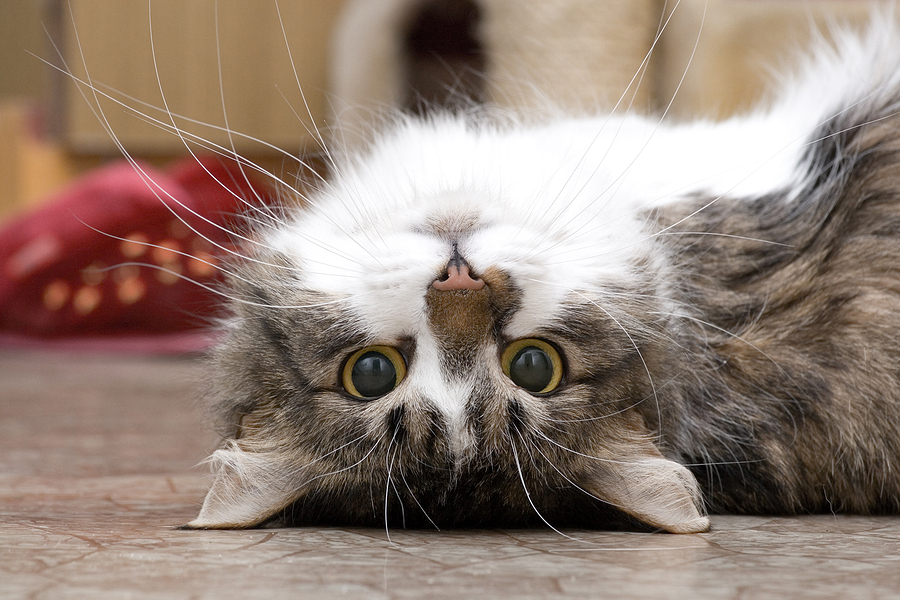Zazie Todd is a pet lover with a Ph.D. in social psychology who brought together her interests when she created the blog Companion Animal Psychology. Todd has just published her second book, “Purr: The Science of Making Your Cat Happy” (the first was “Wag: The Science of Making Your Dog Happy”). Here’s some of what she learned in writing “Purr.” (This interview has been edited and condensed.)

Does catnip make all cats happy?
The catnip response is genetic, so not all cats have it. Kittens don’t have it. It’s something that develops as the cat gets a bit older. There are other substances that some cats will respond to as well, which have the same kind of effect. If you like to see cats rolling around in ecstasy on catnip, you can try silver vine or honeysuckle or valerian. Most cats will respond to at least one of those substances.
How much money do we have to spend on toys before our cats are happy?
Cats can get bored of toys, but you don’t have to keep buying them new ones. If you rotate toys—put them away for a bit and then bring them out again later so cats are always getting different toys– when they come out it’s going to be as if they’re new again. Another thing is that cats sometimes like when their toys start to disintegrate, because it’s more like if they had actually caught something. That’s why cats might like to play with bits of paper or cardboard, so they can actually shred them. Or they might like toys that have feathers, and the feathers fall off. Whereas when we are buying toys, we tend to look for sturdy toys that are going to last a long time. And that’s not necessarily what your cat is going to prefer. They might like something a bit cheaper that will fall apart and then you’ll replace it. But I think variety and novelty are the most important things, whether it’s actual novelty or just you’ve rotated the toys so that they seem as if they’re new.
What does playtime look like?
A younger cat is going to need more playtime than an older cat and a younger cat is going to be more active in the playtime as well, leaping about after a toy. An older cat might spend more time watching and less time leaping, especially if they’ve got arthritis, but that’s okay. Even if they’re just watching the toy, they’re still engaging with it in a way.
Some readers may be surprised to learn that they can train their cats. What are some fun, useful things that you like to teach cats?
I have a training plan in the book for “sit pretty” and that’s one of the first things I taught my cat Melina. It’s really cute when you see a cat doing tricks, but I think it’s also really important to teach them things like how to go in their cat carrier, and there’s a plan for that in the book. It’s really fun to do scent games with cats, which could be as simple as hiding their food in different places around the home.
Someone I know recently told me that she had put a lot of her favorite perfume on her hands and then petted her cat all over because she wanted her to smell nice. Is that going to make a cat happy?
Most cats would not like that at all. Cats like to smell of themselves and scent is really important to them. Their own scent helps them to feel safe and comfortable and secure. They really don’t like strong scents like strongly scented cleaning products or perfumes. If you’re going to wash the cat’s bedding, don’t wash all of their beds at once. Leave one bed that still smells like them so they can feel comfortable there while you wash the other bedding. If you change all of them at once, it’s going to feel a bit stressful for the cat. Cats have brilliant noses so it’s important to respect them.
What are some ways cats use scent?
When cats are rubbing their head on you or on the furniture, they’re transferring pheromones from the scent glands in their face and head. Those pheromones help them to feel comfortable, safe, and secure, and to know that it’s home. If they’re rubbing them on you, it’s kind of like transferring a group scent to you like they would do with other cats that are part of their social group, when they rub heads or even their whole bodies together.
What are some scent games people can play with cats?
You could make it like beginning nose work and spread cardboard boxes around the room, put treats in them, and let your cats go look for them. Cats really love that and it can be a lot of fun for them. Some cats will come running in and start exploring right away and some cats need a bit more time to get used to it. If it’s a shy cat, you have to let them approach in their own time.
One of the things you discuss is kitten socialization. How does that affect feline happiness?
A lot of people don’t know that kittens have a sensitive period for socialization, between the time they’re two weeks to seven weeks old. It happens while the kittens are still with their mother and we just have to build on that when they come into our home and help them continue learning and build on those positive socialization experiences they’ve already had. It’s so important when you are getting a kitten that you get a kitten who’s been raised in a home and has been handled by different people, instead of one raised in a barn, for example, who isn’t used to household sounds and hasn’t really interacted with anyone apart from the person who goes out to feed them. It makes such a big difference in how friendly and confident they are as they grow up into an adult cat.

Why do you think cats get so little respect?
I think a lot of people don’t understand cats very well. And especially for people who’ve grown up with dogs, they’re expecting their cat to be like a dog and they’re quite different. For example, they’ll go to pet the cat on the tummy and the cat will not be happy about it at all. That can surprise people who are more used to dogs. If they understood them better and could read their body language better, I think they would have much more appreciation of cats.
Why are cats hard for us to read?
One thing is that their facial features and their body language is a bit harder to read. And dogs have a longer domestication history with us than cats, so maybe that’s part of it. One thing I learned that I thought was fascinating was some of the research on meows and the fact that we find it harder to understand another cat’s meow compared to our own cats’ meow. When you think about the meow and it being different for each person, that means you can’t just learn that a specific meow always means the cat is hungry. You have to instead use your knowledge of that cat or the environment and context to figure out what the cat means. I also think that people pay more attention to dog body language because they know a dog bite can be quite serious so they have to be careful. With a cat, they’re not paying as much attention and they’re not respecting what the cat might like.
People so often seem to be offended or disappointed that they don’t have a lap cat or a cat who likes to be petted. Do you have any advice or consolation for them?
Every cat is different, and not all cats are lap cats. Some cats may just choose to be near you instead of sitting on your lap. That is their way of showing that they’re part of the same social group and they’re being friendly toward you. If they’re sitting in the same room, they’re choosing to be in the same room as you, and that is something to be pleased about. If they’re sitting next to you, that is also something to be pleased about. You can try to encourage them to be lap cats by giving them food rewards if they sit on your lap, but you have to accept your cat for who they are and appreciate the affection that you do get from them. And when you’re petting your cat, make sure that petting sessions don’t go on for too long. Aim for short, frequent interactions instead; that’s much more what cats like. Then they’re more likely to want to spend time with you.
Do cats have favorite types of toys?
That’s a great question. We know that play in cats is using their predatory behavior, and it’s really important for them to have those opportunities. And every cat is different. Some cats will specialize in a certain kind of prey and therefore they’ll like a certain kind of toy more, whereas some cats are more generalists and they like all kinds of different toys. It’s a good idea for them to have toys that resemble different types of prey like mice or birds or a snake or fish, because that gives them different types of play to engage in. It’s also a really good idea to have some kind of interactive toy and make time for them to play with you every day. We know from the research that more interactive play tends to reduce behavior issues, or it makes cats less likely to have behavior issues.

How can people make veterinary visits a happy experience for their cats?
So many people find it difficult to get their cats to the vet, but we know now from research that when you train a cat to go in their carrier, it makes the vet visit easier. It’s not just easier for you to get the cat in the carrier to go to the vet, they’re actually less stressed at the vet. It’s a good idea to have a cat carrier where you can take the top off so the cat can be in the base of the carrier while the vet examines them. The book has a plan for training cats to go in their carriers. I hope that will help a lot of people because it’s not very nice when you’ve got an appointment to be at the vet and you get your carrier out and the cat disappears. It’s much, much easier when they’re used to going in it and relaxing. Even an old cat can learn or even a cat who’s terrified of their carrier. It just means you have to go a bit more slowly, but a few minutes a day over several weeks or months will make a big difference.
What else should people know about feline happiness?
Cats remain fascinating, mysterious creatures, but there is a lot we know now that we didn’t use to, that helps us to give them a happier life.
This article was reviewed/edited by board-certified veterinary behaviorist Dr. Kenneth Martin and/or veterinary technician specialist in behavior Debbie Martin, LVT.








